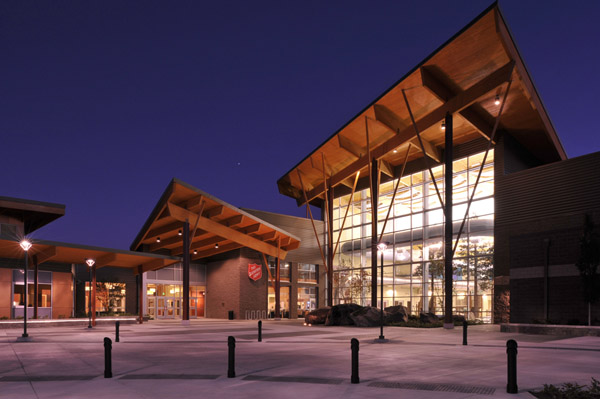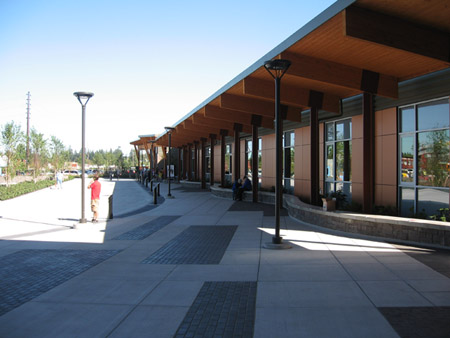Building Statistics

Ray and Joan Kroc Corp Community Center
1865 Bill Frey Drive Salem, OR 97301
| Owner: |
Salvation Army |
| Function Type: |
Community Center |
| Size: |
92,000 SF |
| Floors: |
1 |
| Dates of Construction: |
May 2008 - September 2009 |
| Total Construction Cost: |
$33 Million (Approximate) |
| Project Delivery Method: |
Design-Bid-Build |
| General Contractor: |
LCG Pence Construction, LLC |
www.lgcpence.com |
| CM: |
LCG Pence Construction, LLC |
www.lgcpence.com |
| Architects: |
Barker Rinker Seacat Architecture |
www.brsarch.com |
| Associate Achitects: |
CB2 Randaw Architects |
www.cbtwoarchitects.com |
| Landscape Architects: |
Christopher Freshley,
Landscape Architect |
N/A |
| Acoustical Engineer: |
Sparling |
www.sparling.com |
| Electrical Engineers: |
Reese Engineering |
www.reeseinc.com |
Mechanical and
Plumbing Engineers: |
GLUMAC International |
www.glumac.com |
| Aquatic Design: |
Water Technology Inc |
www.watertechnologyinc.com |
| Civil Engineer: |
Westech Engineering |
www.westech-inc.com |
| Structural Engineers: |
Miller Consulting Engineer |
www.millerengrs.com |
|
Architecture:
The Kroc Center was designed to be a safe, alternative place for children from troubled neighborhoods. The Kroc Center contains a lot of different spaces to meet the many needs of the community. It has two pools, a competition pool and a leisure pool. There is also a chapel/theater, kitchen, fitness area, and a full-size gymnasium. Additionally, the building has a number of smaller classrooms, play areas, and gathering spaces for people in the community to use. One of the defining characteristics of the Kroc Center is the large wooden canopies that cover the exterior entrances.
Applicable Building Codes
The building was built to adhere to IBC 2006, IMC 2003, IPC 2003, UFC 2003, NEC 2002, and zoning established by City of Salem Planning and Zoning Department. |
Building Enclosure:
The building enclosure for the Kroc Center has several façade types on CMU backup. The different facades include: two types of metal siding, veneer CMU, split-face CMU, wood, and glazing. The glazing is a 1” insulating glass.
The roofing assembly consists of a mechanically anchored TPO on much of the roof and standing seam metal panels on the larger overhangs. The roofs are mounted above 2 1/2" of insulation, a vapor barrier, and either metal deck or Alaskan Yellow Cedar decking. |
 |
|
Sustainability Features:
The designers of this building were very concerned with sustainability. They took a number of steps to achieve LEED Certification and are currently on track to receive a LEED Silver rating under LEED v. 2.2. Below is a list of some of the sustainable features they employed:
- High Performance Glazing
- Window Shading
- Increased Wall Insulation
- High Efficiency Condensing Boilers
- Improved Fan Power
- VAV Air Distribution System
- Reduced Water Use
- Using Regional and Recycled Materials
|
Systems Summary
Structural
The Kroc Center utilizes an all steel structure with a concrete slab. The columns range in size from HSS4x4 to HSS8x8. The columns support the roof beams which range in size from W10x22 to W36x150, with the majority of them being W12x40 beams. Since the Kroc Center is only one story, all of the concrete slabs are on grade and but range in thickness from 4” up to 12”. Shear walls are spread throughout the building and are made up of CMU’s that are 8 to 12” thick. The foundation consists of concrete spread footings under each of the columns.
Mechanical
Fourteen primary air handlers supply conditioned air and outdoor air to the spaces. Three of the air handlers use VAV boxes and VFDs to provide more accurate ventilation and save energy; the rest of the air handlers are constant volume systems. All of the primary air handlers are packaged units mounted on the roofs. Three natural gas boilers provide hot water to the two pools and the two largest air handlers. The remainder of the air handlers have small natural gas furnaces in the units that supply heat for the hot water. All of air handlers have small DX cooling systems that supply cool water to the cooling coils. Small water heaters are located in the building to provide hot domestic water.
Lighting/Electrical
The Kroc Center uses a 3000 amp, 480/277V electrical service. The electricity passes through a transformer, supplied by the power company, then it enters the MDC. From here the power is distributed directly to three of the mechanical units and to six main distribution panels. Each of the six distribution panels feed a transformer that reduces the voltage to 208/120V then feeds another panel. These low voltage panels feed the receptacles and switches.
The building uses a wide variety of luminaries throughout the building with both 277V and 120V power. It uses primarily fluorescent lighting, but some incandescent and metal halide luminaries are used for special lighting requirements.
Construction
The Kroc Center was a new construction that was delivered as a Design-Bid-Build project. Barker Rinker Seacat Architecture led the design team and construction began in May 2008. LCG Pence Construction was the general contractor and finished work on the $33 million building in September of 2009.
Fire Protection
A fire protection design is not explicitly laid out in the contract documents, but a fire main does bring water into the sprinkler valve room. From there the fire main is split into two panels that will serve two different areas of the building. The actual layout of the sprinklers heads and piping were to be performed by the fire protection contractor. |
|
All images are coutesy of Reese Engineering Inc.
|
|
Note: While great efforts have been taken to provide accurate and complete information on the pages of CPEP, please be aware that the information contained herewith is considered a work-in-progress for this thesis project. Modifications and changes related to the original building designs and construction methodologies for this senior thesis project are solely the interpretation for Mathias Kehoe. Changes and discrepancies in no way imply that the original design contained errors or was flawed. Differing assumptions, code references, requirements, and methodoliges have been incorporated into this thesis project; therefore, investigation results may vary from the original design. |
|


